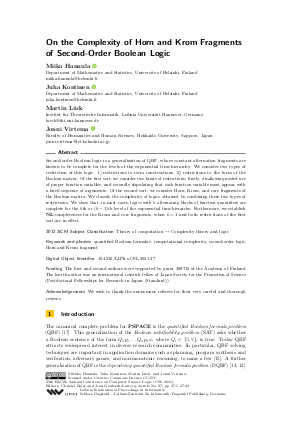LIPIcs.CSL.2021.27.pdf
- Filesize: 0.62 MB
- 22 pages

 Creative Commons Attribution 3.0 Unported license
Creative Commons Attribution 3.0 Unported license

Second-order Boolean logic is a generalization of QBF, whose constant alternation fragments are known to be complete for the levels of the exponential time hierarchy. We consider two types of restriction of this logic: 1) restrictions to term constructions, 2) restrictions to the form of the Boolean matrix. Of the first sort, we consider two kinds of restrictions: firstly, disallowing nested use of proper function variables, and secondly stipulating that each function variable must appear with a fixed sequence of arguments. Of the second sort, we consider Horn, Krom, and core fragments of the Boolean matrix. We classify the complexity of logics obtained by combining these two types of restrictions. We show that, in most cases, logics with k alternating blocks of function quantifiers are complete for the kth or (k-1)th level of the exponential time hierarchy. Furthermore, we establish NL-completeness for the Krom and core fragments, when k = 1 and both restrictions of the first sort are in effect.




Feedback for Dagstuhl Publishing